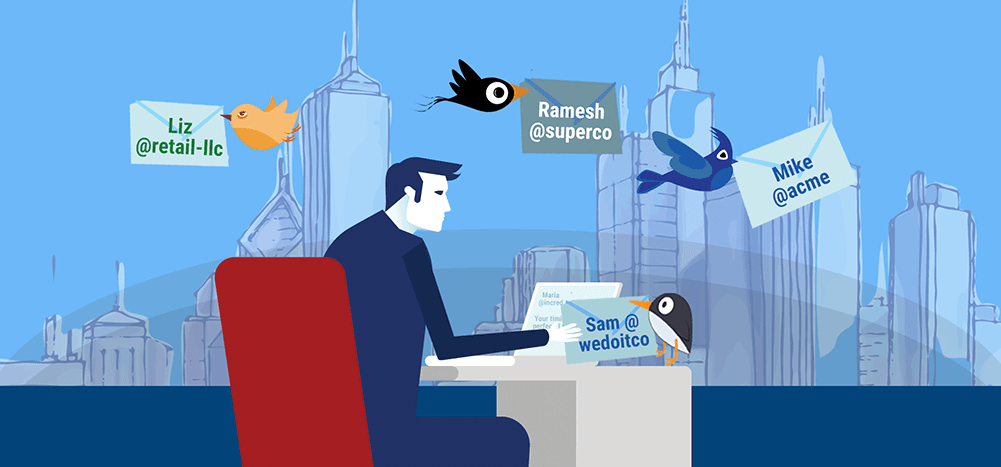
Email personalization lets you create individual email experiences for each recipient in your mailing list.
However, to personalize emails effectively, you’ll first need to collect data on the target audience. Then, you’ll have to segment your email list and decide on the right personalization strategy for effective targeting.
Worried that personalizing email campaigns is complicated?
Don’t be.
To help you out, I’ll explain what email personalization is and go over its three key benefits. I’ll then provide a step-by-step guide on sending a personalized email campaign and share seven no-nonsense email personalization tips to improve your conversion rate.
Further Reading:
- Learn how to write B2B emails using seven email template examples and five handy tips.
- Need help crafting your cold email? Check out my article on cold email copywriting for all you need to know.
This Article Contains:
(Click on links to jump to specific sections)
- What Is Email Personalization?
- 3 Key Benefits of Personalizing Your Emails
- How to Send a Personalized Email Campaign: Step-by-Step Guide
- 7 Practical Email Personalization Tips to Boost Your Conversions
Let’s go!
What Is Email Personalization?
Email personalization is the process of creating tailor-made emails for your recipients using the data you have on them. It allows you to send timely emails with relevant content that engages your audience and gets responses.
At its most basic level, email personalization involves adding the recipient’s name to your email.
But that’s only the tip of the iceberg.
You can add personalized content in your emails based on the recipient’s:
- Location.
- Interests.
- Demographic.
- Important anniversaries.
- Job title.
- Website behavior.
- Purchase history, and more.
Here’s a video recommendation email from TED based on a subscriber’s viewing history:
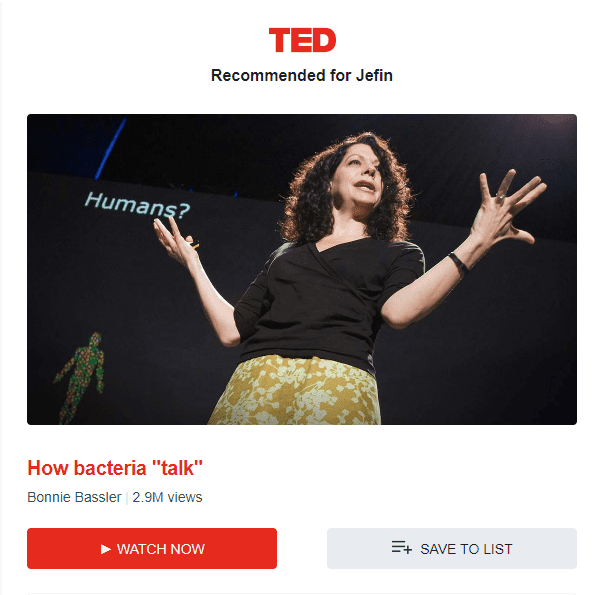
Now that you know what email personalization is, let’s quickly go over why you should do it in the first place.
3 Key Benefits of Personalizing Your Emails
Here are three reasons why you should personalize your email campaigns:
- Higher Open Rate: a personalized email subject line grabs the recipient’s attention and can boost your open rate by 26%.
- Better Customer Engagement: since generic content annoys 42% of customers, you can improve customer engagement by personalizing your email content.
- High ROI: personalized emails have the potential to increase your revenue by 760%, so investing in email marketing personalization is a clever idea.
Next, I’ll go over how you can create and send an effective personalized email campaign.
How to Send a Personalized Email Campaign: Step-by-Step Guide
Just follow these steps for creating and sending a solid personalized email campaign:
Step #1: Gather the Data for Personalizing Your Emails
Before you can personalize emails, you’ll need data about your recipients.
For example, if you want to send birthday emails to subscribers, you’ll need to know when their birthday is.
One tactic you can use to collect customer data is a lead magnet.
What’s that?
A lead magnet is a free item you offer prospects in exchange for providing their data, such as:
- An ebook.
- A case study.
- An industry report.
- A tutorial, and more.
In return for giving them free value, you can ask prospects for their name, company name, occupation, contact info, birthday, location, etc.
But lead magnets aren’t the only way to gather customer data.
You can also get details like the total number of orders or the total amount spent by a customer from your Customer Relationship Management (CRM) system. Moreover, you can leverage website tracking to gather data on your customers’ preferences.
Step #2: Segment Your Email List for Effective Targeting
After you’ve collected data on prospects, it’s time for segmentation.
What’s segmentation?
Simply put, segmentation is the process of dividing your target audience into smaller groups based on some common characteristics.
You can segment prospects based on their:
- Gender.
- Location.
- Job title.
- Demographics.
- Interests, and more.
Why perform segmentation in the first place?
Simple — to send more relevant marketing emails to your recipients!
For instance, let’s say you own an eCommerce store selling accessories.
If you’ve segmented the email list based on gender, sending a mass email campaign exclusively to your female audience about a sale on women’s handbags would be a piece of cake.
That’s not all.
You can also dive deeper and segment the email list based on your customers’ buying behavior, purchasing frequency, and level of engagement on your website.
By doing so, you can send targeted emails that provide recipients with a personalized experience.
Step #3: Include Personalization Data in Your Email Copy
Once you’ve segmented the recipients, the next step is inserting the personalization data.
But where should you add this data?
Here are the two main parts of your email where you can leverage personalization:
A. Subject Line
I recommend starting with your subject line since it’s one of the first things a recipient notices about your email. In fact, almost half of your recipients will decide to open the email based on your subject line.
That’s why you need a catchy, personalized subject line.
In your subject line, you can mention the prospect’s:
- Name.
- Company name.
- Location.
- Goals.
- Pain points.
Here’s a subject line personalized with the subscriber’s name:
![]()
Need help with crafting your subject lines?
Check out:
- 43 high-converting cold email subject lines.
- 20 follow-up email subject lines that get your emails opened.
- 30 networking email subject lines that work.
B. Email Body
You can take email personalization up a notch in your email body.
For example, you can elaborate on a solution to the potential customer’s unique problems in your email body. Alternatively, you can add personalized product recommendations to the email body based on a customer’s purchase history or browsing history.
Check out this email from Coursera with personalized product recommendations:
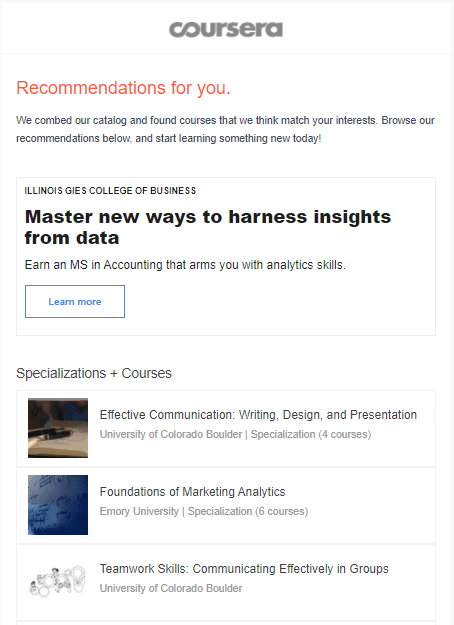
But how do you personalize each email when dealing with a large email list?
Email personalization is effortless when using a robust email marketing and marketing automation tool like GMass.
With GMass, you can use custom fields to automatically personalize everything about your mass email campaign, including the subject lines, paragraphs, links, images, attachments, and more.
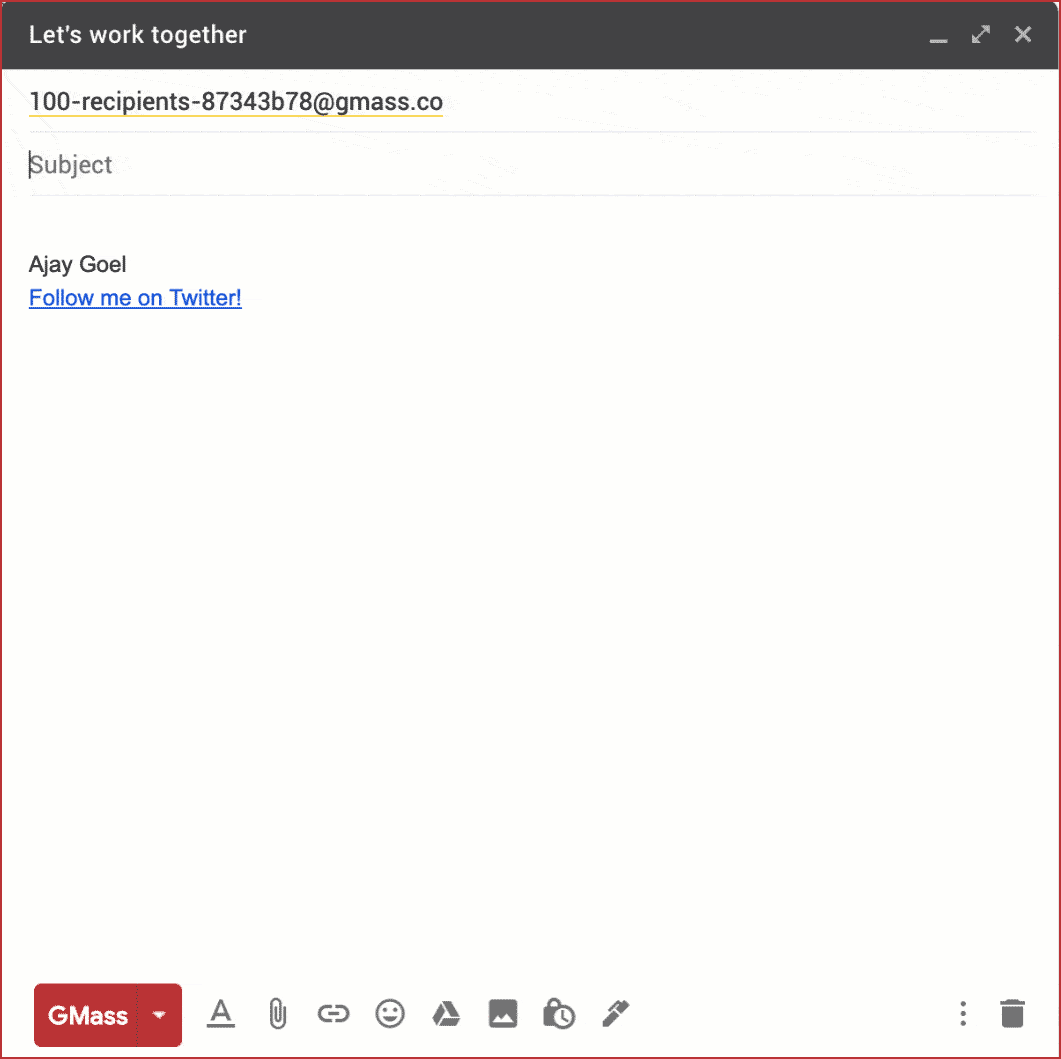
This way, sending personalized email campaigns at scale becomes a breeze!
Step #4: Schedule Your Emails to Reach Prospects at Optimal Times
Email personalization doesn’t stop at adding dynamic content to your emails.
You’ll also need to personalize the email sending schedule so that your targeted emails reach prospects at optimal times.
What’s the best time to send your email?
Studies recommend that you send emails between 9 am and 11 am on Tuesday or Thursday — that’s when the open rate is usually at its peak.
However, this is a rule of thumb.
You can use A/B testing to determine what time works best for your prospects.
In A/B testing, you pick two different times to send your personalized emails and see which time works better for your recipients. Then, you repeat this process using other send times till you find the one that works best.
After identifying the optimal send time, just schedule your personalized email marketing campaign to go out then.
Fortunately, scheduling your email messages is easy with an email marketing automation tool like GMass.
Simply pick a pre-configured date/time from the scheduling settings or enter a custom date/time to your liking. Then, GMass will automatically send your personalized emails at the scheduled time (in your local time zone).
And if you want to reschedule your emails, you can easily modify the scheduled date/time right inside your Drafts folder.
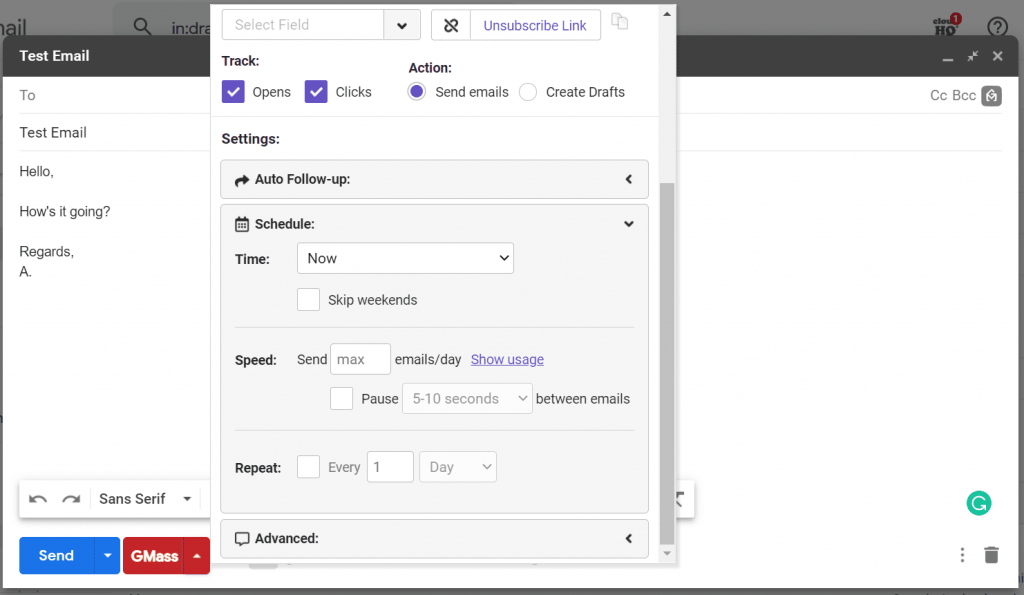
Step #5: Create Automated Workflows to Send Behavior-Based Emails
Let’s say you’ve sent out a personalized email campaign.
Now, some of your recipients will:
- Open your email.
- Respond to it.
- Click on a link inside.
- Ignore the message.
A great way to keep recipients engaged is to send them personalized emails based on how they interacted with your email marketing campaign. In other words, you’ll need to create a workflow that sends behavior triggered emails.
With GMass, you can effortlessly set up a workflow to send automated email follow-ups based on recipients’ actions on your previous outreach or promotional emails.
For example, you can send a follow-up email to those who didn’t open your email or who opened your email but didn’t click any URLs inside.
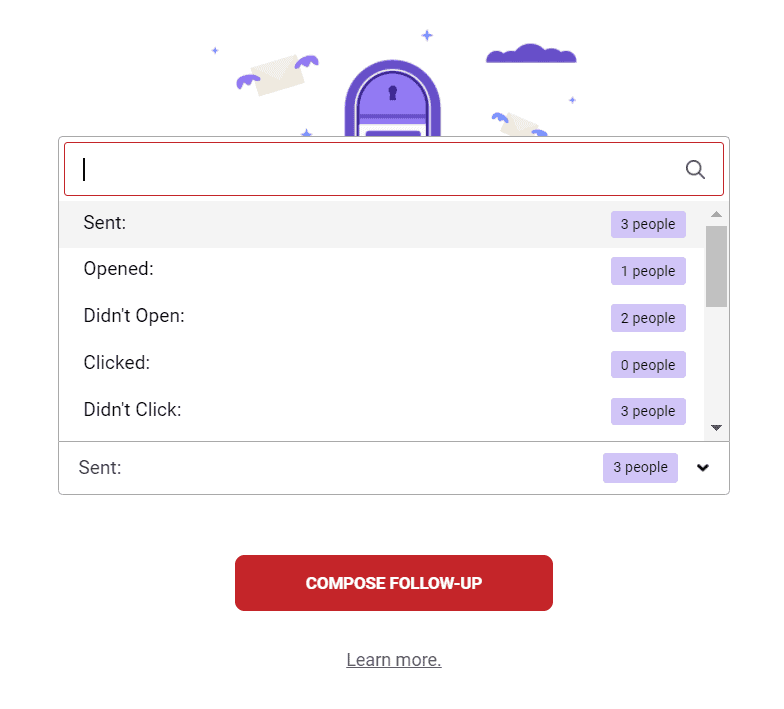
Let’s now go over some no-nonsense tips to help you excel at email personalization.
7 Practical Email Personalization Tips to Boost Your Conversions
Here are seven actionable tips you can follow to level up your email personalization game:
1. Develop Buyer Personas of Your Target Audience
For effective email marketing personalization, you need a clear idea of who you’re writing for.
That’s where buyer personas come in.
What’s a buyer persona?
A buyer persona is a comprehensive description of someone who represents your target audience. Since your business might cater to various customers, you’ll need multiple buyer personas to cover your target audience.
Let’s consider the example of a real estate agency in Palo Alto to understand this.
One of your buyer personas might describe a software engineer working in the Silicon Valley, earning $250,000 annually.
Another buyer persona might describe a multi-millionaire with a family heading a tech unicorn.
By defining buyer personas, your marketers will have a better grip on the type of personalized content to include in your emails and the tone to use. Your marketers can then craft targeted email messages that resonate with the buyer, increasing your engagement chances.
2. Humanize Your Email’s Sender Details
68% of recipients open an email based on its “from” name.
And it makes perfect sense.
You see an email from someone you trust, and you’d want to give it a read.
Note that I’ve used the word “someone” here.
But why?
Most companies use their brand’s name and logo for the sender details.
At first look, there’s nothing wrong with this approach because your subscribers have signed up for marketing emails from your brand.
However, receiving emails from a brand or business can seem impersonal after a while.
A better approach is to humanize your sender details by using a person’s name in the “from” field and their face instead of your brand logo. Your recipients will appreciate emails from real people and be more likely to respond.
For example, when you’re emailing existing customers, sending your marketing emails from the account manager or sales rep’s account gives a more personal touch.
I send GMass emails with my name in the “from” field so that our subscribers feel like they’re hearing directly from me:
![]()
3. Reference a Mutual Contact to Foster Trust
If you’re sending a cold email to a potential customer, referencing a mutual connection helps build trust.
Your potential customer may not know who you are, but the fact that you share a mutual contact will make them feel at ease about talking to you.
How exactly do you reference a mutual contact?
Try using a personalized subject line like “[Mutual connection] suggested that we talk”.
This subject line will help you break the ice and capture the reader’s attention, getting them to open your email. And you can elaborate on how you know the mutual connection in your cold email body.
Then, you can slowly segue into talking about why you’re reaching out and how it’ll benefit the prospect.
4. Build Rapport by Highlighting Commonalities
The quickest way to build rapport with a recipient is by highlighting commonalities in your email.
What do I mean by that?
You and the potential customer may share a common:
- Interest.
- Goal.
- Background.
- Challenge.
- Value, and more.
Mentioning a commonality shows that you’re not very different from each other and that you’ve researched them well.
Commonalities work because they make it easier for a potential customer to trust you.
But how do you find those commonalities?
Easy — check out their profiles on social media platforms like LinkedIn, Twitter, and Facebook.
Ideally, you’ll want to find an unusual or a rare commonality.
For example, if you’re an American reaching out to another American living in the United States, pointing out that you’re both American may not help your case. There are tons of people just like you, so you won’t stand out.
However, say you both love to surf. Since not many people can say that, you can leverage this commonality. You could mention your favorite surfing spots in Florida or Hawaii and ask the prospect where they like to surf.
5. Add a Compliment Based on a Trigger Event
Adding a compliment to your outreach email is a smart personalization tactic.
It’ll make the recipient feel seen and appreciated, increasing the chances that they’ll respond to your personalized message.
However, your compliments will need to be specific if they’re to work.
For example, saying something like “I’m impressed with your achievements” won’t cut it. Instead, you’ll need to specify what achievement really stood out to you — it could be about a funding round they led, a revenue milestone they achieved, etc.
Compliments make the recipient feel good and show you’ve done your research on them.
Wondering what to compliment a prospect on?
Start by looking for exciting updates on their social media handles.
If you can’t find anything on the social media pages, Google the prospect and see if there are any press mentions featuring their achievements.
Based on what you see online, craft an email with a genuine compliment your prospects will appreciate.
6. Mention Solutions to Prospect’s Pain Points in Your Email
Your prospects don’t need more promotional emails in their inbox.
They’ve got plenty already.
Instead, what they could use are solutions to their unique pain points.
You can personalize your email content to talk about your recipients’ pain points and share solutions for overcoming them. For example, you could point them to a helpful blog post, link to a case study, cite a research paper, etc.
This email personalization technique has twin benefits:
- Mentioning pain points shows that you understand the subscriber and their needs.
- Offering solutions tells your prospects that you care about helping them out and showcases your expertise.
As a result, your recipients will look forward to responding to your personalized email marketing message, and you can cultivate brand loyalty.
This email from Credit Karma talks about high auto insurance premiums, a pain point many car owners share:
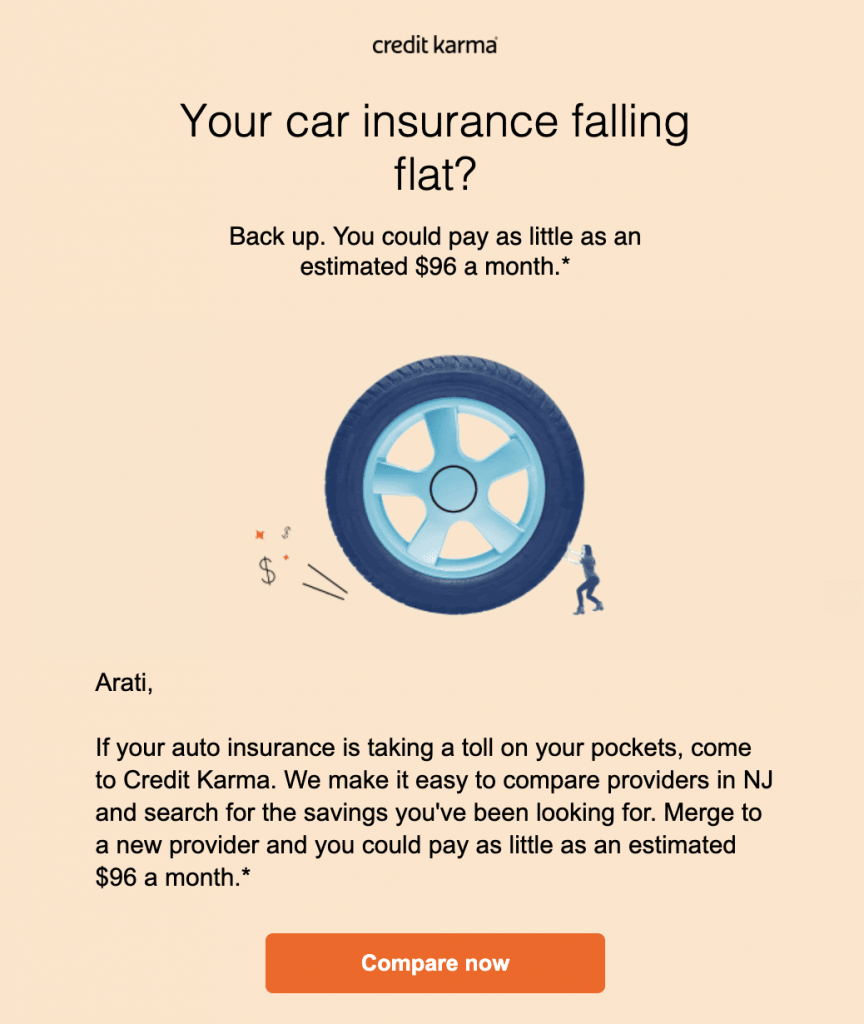
7. Send Timely Emails Based on the Customer Journey
Asking a recipient to buy your product in your first email is salesy and will put them off.
Similarly, if a prospect added an item to their shopping cart but didn’t check out, not sending them a follow-up can cost you a potential sale.
My point?
You’ll need to send a timely, personalized email based on where your prospect is in the customer journey to help them advance to the next stage.
Here’s an abandoned cart email from Amazon reminding the recipient to check out:

However, data about your prospects is crucial for this process to work.
For example, you’ll need to track a user’s actions on your website in real-time to send out an abandoned cart email. This way, you’ll know exactly why the cart abandonment happened.
Based on that info, you can personalize your abandoned cart email for maximum effectiveness.
Final Thoughts
Email personalization is more than just including a personalization tag in your subject line.
By sending relevant content to your audience in the form of birthday emails, personalized product recommendation emails, etc., you can enhance conversions and improve engagement. Most importantly, by providing a personalized experience, you can build brand loyalty.
But to really step up your personalization strategy, you need a robust email tool like GMass.
GMass lets you automatically personalize your mass emails at scale, send behavior-based emails, analyze metrics like open and click-through rates, and do so much more.
Why not add GMass to your email marketing strategy today and level up your email personalization efforts?
Email marketing, cold email, and mail merge all in one tool — that works inside Gmail
TRY GMASS FOR FREE
Download Chrome extension - 30 second install!
No credit card required











What if a business had an email list containing hundreds, perhaps thousands of client names and that business wanted to send his list an email, but he wanted to put EACH PERSON’S NAME on EACH EMAIL. For example, an email to John, another to Sam, and another to Joe and so on. Can you help with this?
Hi William,
You can use our auto-detection of first names. If the recipient address contains a name, GMass will use it so that you can address your recipients by name.
https://www.gmass.co/blog/mail-merge-personalization/